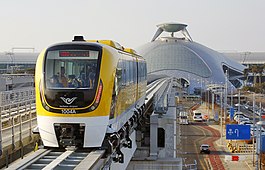| Incheon Airport Maglev | |||||||||||||||||||||||||||||||||||||||||||||||||||||||||||||||||||||||||||
|---|---|---|---|---|---|---|---|---|---|---|---|---|---|---|---|---|---|---|---|---|---|---|---|---|---|---|---|---|---|---|---|---|---|---|---|---|---|---|---|---|---|---|---|---|---|---|---|---|---|---|---|---|---|---|---|---|---|---|---|---|---|---|---|---|---|---|---|---|---|---|---|---|---|---|---|
 | |||||||||||||||||||||||||||||||||||||||||||||||||||||||||||||||||||||||||||
 | |||||||||||||||||||||||||||||||||||||||||||||||||||||||||||||||||||||||||||
| Overview | |||||||||||||||||||||||||||||||||||||||||||||||||||||||||||||||||||||||||||
| Native name | 인천공항 자기부상철도 (仁川空港 磁氣浮上鐵道) Incheon Gonghang Jagi Busang Cheoldo | ||||||||||||||||||||||||||||||||||||||||||||||||||||||||||||||||||||||||||
| Status | Permanently Closed | ||||||||||||||||||||||||||||||||||||||||||||||||||||||||||||||||||||||||||
| Termini | |||||||||||||||||||||||||||||||||||||||||||||||||||||||||||||||||||||||||||
| Stations | 6 | ||||||||||||||||||||||||||||||||||||||||||||||||||||||||||||||||||||||||||
| Service | |||||||||||||||||||||||||||||||||||||||||||||||||||||||||||||||||||||||||||
| Type | Maglev | ||||||||||||||||||||||||||||||||||||||||||||||||||||||||||||||||||||||||||
| Operator(s) | Incheon Transit Corporation, Incheon International Airport Corporation | ||||||||||||||||||||||||||||||||||||||||||||||||||||||||||||||||||||||||||
| Rolling stock | 4 × 2-car Hyundai Rotem Ecobee | ||||||||||||||||||||||||||||||||||||||||||||||||||||||||||||||||||||||||||
| History | |||||||||||||||||||||||||||||||||||||||||||||||||||||||||||||||||||||||||||
| Opened | 3 February 2016[1] | ||||||||||||||||||||||||||||||||||||||||||||||||||||||||||||||||||||||||||
| Technical | |||||||||||||||||||||||||||||||||||||||||||||||||||||||||||||||||||||||||||
| Line length | 6.1 km (3.8 mi) | ||||||||||||||||||||||||||||||||||||||||||||||||||||||||||||||||||||||||||
| Number of tracks | 2 | ||||||||||||||||||||||||||||||||||||||||||||||||||||||||||||||||||||||||||
| Track gauge | 1,850 mm (6 ft 27⁄32 in) | ||||||||||||||||||||||||||||||||||||||||||||||||||||||||||||||||||||||||||
| Electrification | 1,500 V DC third rail linear motor | ||||||||||||||||||||||||||||||||||||||||||||||||||||||||||||||||||||||||||
| Operating speed | 80 km/h (50 mph) | ||||||||||||||||||||||||||||||||||||||||||||||||||||||||||||||||||||||||||
| Signalling | ATC/ATO | ||||||||||||||||||||||||||||||||||||||||||||||||||||||||||||||||||||||||||
| Highest elevation | 24.5 m (80 ft) | ||||||||||||||||||||||||||||||||||||||||||||||||||||||||||||||||||||||||||
| |||||||||||||||||||||||||||||||||||||||||||||||||||||||||||||||||||||||||||
| Incheon Airport Maglev | |
| Hangul | 인천공항 자기부상철도 |
|---|---|
| Hanja | |
| Revised Romanization | Incheongonghang jagibusangcheoldo |
| McCune–Reischauer | Inch'ŏnkonghang chagipusangch'ŏldo |
The Incheon Airport Maglev[2] was a maglev line in South Korea that opened on 3 February 2016 and closed on 1 September 2023.[3] It was the world's second commercially operating unmanned urban maglev line after Japan's Linimo. The trains were lighter, cutting construction costs in half.[4] The majority of construction was completed by November 2012.
The maglev linked Incheon International Airport Terminal 1 to Long Term Parking, Incheon Airport Administration Complex, Paradise City entertainment precinct, and Yongyu station and Leisure Complex while crossing Yeongjong Island.[5] The line is not part of the Seoul Metropolitan Subway System. It was free of charge for all riders. It initially operated between 09:00 and 18:00. Hours had been extended to between 07:30 and 20:00. Departures were every 15 minutes from all stations. It offered a transfer to Incheon International Airport Terminal 1 station of AREX.[6]
This maglev line specifically utilized electromagnetic suspension (EMS) and linear induction motor (LIM) propulsion.[7] The train was one of the first commercial maglev trains since the 1980s. Two more stages were planned of 9.7 km (6.0 mi) and 37.4 km (23.2 mi). Once completed it would have become a circular line.[8][9][10] These lines made up a core project that the Korea Rail Network Authority managed.[7]
- ^ "도시형 자기부상철도 3일 개통…세계 두번째". 매일경제. 2 February 2016.
- ^ "Incheon maglev rail under construction". Korea JoongAng Daily. 3 August 2010. Retrieved 3 February 2014.
- ^ "About maglev train". Retrieved 30 December 2023.
- ^ "오늘 인천공항~용유동 자기부상열차 개통". 기호일보 - 아침을 여는 신문 (in Korean). 2 February 2016.
- ^ "KBS World". Retrieved 26 September 2010.
- ^ "인천공항 자기부상철도 3일 개통…무료로 운행한다". Yonhap News Agency (in Korean). 2 February 2016.
- ^ a b Park, D. Y.; Shin, B. C.; Han, H. (1 November 2009). "Korea's Urban Maglev Program". Proceedings of the IEEE. 97 (11): 1886–1891. doi:10.1109/JPROC.2009.2030247. ISSN 0018-9219. S2CID 20955600.
- ^ Song, C. H.; Park, K.S.; Kim, C. K. (10–13 October 2011). Review on Incheon International Airport & Urban MagLev Interface. The 21st International Conference on Magnetically Levitated Systems and Linear Drives. Daejeon, Korea. p. 5. Archived from the original (PDF) on 21 December 2011. Retrieved 10 July 2018.
Phase 2 expansion line is planned to link coastal area and cover 9.7km with 5 train stations up to the international business complex II of IIA and Phase 3 or the last phase expansion line is designed to be a ring-type alignment circumnavigating Yeongjong Island around IIA, covering 37.4km with 16 train stations.
- ^ Han, Woojin. "영종자기부상열차 2단계". 미래철도DB (in Korean). Retrieved 9 July 2018.
- ^ Medimorec, Nikola (28 January 2012). "Maglev at Incheon International Airport to be completed this year". Kojects. Retrieved 10 July 2018.
Two more stages of construction are planned for the line; stage two is a 9.7km extension that continues from Yongyoo Station, past the planned Marine World and up to Dragon City. Though this stage was originally scheduled to be completed in time for the Asian Games, setbacks in the development of neighboring projects are still causing delays. The final stage will be significantly longer, a 37.4km extension that continues around the outer rim of the island and loop back to the airport.
